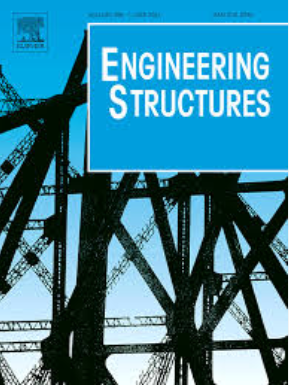用于地震波减缓的嵌套质量局部共振超障
IF 6.4
1区 工程技术
Q1 ENGINEERING, CIVIL
引用次数: 0
摘要
地震超材料(SMs)由于其特殊的操纵波的能力而在地震工程中引起了极大的关注。这些SMs起源于电磁学和声学领域,由嵌入土壤中的工程结构的周期性阵列组成,以保护建筑物免受地震波的影响。在本文中,我们提出了一种嵌套质量超势垒,它可以利用其内核的局部共振现象产生低频带隙。基于分析研究、参数分析和施工可行性,所开发的超屏障由胶合板外壳内的混凝土核心组成,并由软聚乙烯泡沫连接。色散分析表明,所提出的超屏障可以产生0.8-3.2 Hz的低频带隙,该带隙在地震波的频率范围内(低于10 Hz)。实验室尺度的实验和数值模拟进一步验证了亚阻挡层在带隙范围内衰减传播纵波的性能。因此,所提出的超屏障设计表明具有理想的波衰减,并且在施工中是可行的,显示了其在地震防护中的实际应用潜力。本文章由计算机程序翻译,如有差异,请以英文原文为准。
Nested-mass locally resonant metabarriers for seismic wave mitigation
Seismic metamaterials (SMs) have garnered significant attention in earthquake engineering due to their exceptional ability to manipulate waves. Originating from the fields of electromagnetics and acoustics, these SMs consist of periodic arrays of engineered structures embedded in the soil to protect buildings from seismic waves. In this paper, we propose a nested-mass metabarrier, which can produce a low-frequency band gap utilizing the local resonance phenomenon of its inner core. Based on analytical studies, parametric analysis, and construction feasibility, the developed metabarrier comprises a concrete core inside a plywood shell and is interconnected by soft polyethylene foam. Dispersion analysis shows the proposed metabarrier can generate a low-frequency band gap of 0.8–3.2 Hz, which falls within the frequency range of seismic waves (below 10 Hz). Lab-scale experiments and numerical simulations further verify the performance of the metabarriers in attenuating propagating P-waves in sand at frequencies within the band gap. The proposed metabarrier design is therefore shown to have desired wave attenuation and is feasible for construction, demonstrating its potential for practical application in seismic protection.
求助全文
通过发布文献求助,成功后即可免费获取论文全文。
去求助
来源期刊

Engineering Structures
工程技术-工程:土木
CiteScore
10.20
自引率
14.50%
发文量
1385
审稿时长
67 days
期刊介绍:
Engineering Structures provides a forum for a broad blend of scientific and technical papers to reflect the evolving needs of the structural engineering and structural mechanics communities. Particularly welcome are contributions dealing with applications of structural engineering and mechanics principles in all areas of technology. The journal aspires to a broad and integrated coverage of the effects of dynamic loadings and of the modelling techniques whereby the structural response to these loadings may be computed.
The scope of Engineering Structures encompasses, but is not restricted to, the following areas: infrastructure engineering; earthquake engineering; structure-fluid-soil interaction; wind engineering; fire engineering; blast engineering; structural reliability/stability; life assessment/integrity; structural health monitoring; multi-hazard engineering; structural dynamics; optimization; expert systems; experimental modelling; performance-based design; multiscale analysis; value engineering.
Topics of interest include: tall buildings; innovative structures; environmentally responsive structures; bridges; stadiums; commercial and public buildings; transmission towers; television and telecommunication masts; foldable structures; cooling towers; plates and shells; suspension structures; protective structures; smart structures; nuclear reactors; dams; pressure vessels; pipelines; tunnels.
Engineering Structures also publishes review articles, short communications and discussions, book reviews, and a diary on international events related to any aspect of structural engineering.
 求助内容:
求助内容: 应助结果提醒方式:
应助结果提醒方式:


